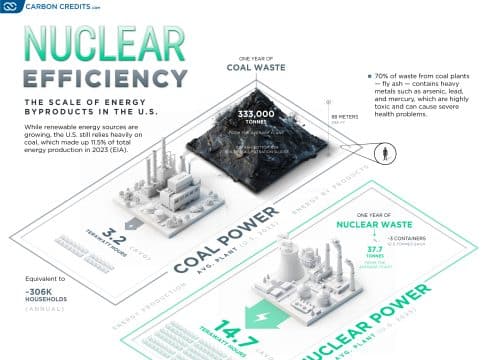Nuclear Power vs. Coal: Three Reasons Why Only One Will Power The Next Decade
Global power generation is evolving
With an increasing number of renewable energy sources being harnessed, right now, nuclear power is catching the most attention in the move to cleaner energy.
The International Energy Agency estimates that global nuclear generation will be 10% higher in 2025 than it was in 2023. By 2026, nearly half of the world’s electricity will come from low-emission sources, including nuclear.
The United States operates 93 commercial nuclear reactors that collectively produce approximately 780 billion kilowatt-hours (TWh) of electricity, which is a substantial amount of energy.
This output is sufficient to power more than 72 million homes and represents nearly 47% of the nation’s total electricity generation, according to the U.S. Office of Nuclear Energy.
Yet, as you can see in the infographic, the US is still heavily reliant on fossil fuels.
In 2023, coal made up about 8.7% of total energy consumption and 18.6% of electricity production. And there are approximately 210 coal plants running across the country right now.
Each coal plant pumps out about 3.2 terawatt-hours (TWh) of energy—enough to power roughly 306,000 homes.
Still, it’s important to note that coal plants also generate a ton of waste. Each plant releases around 333,000 tonnes of waste yearly, contributing to a total of 70 million tonnes of coal waste. And 60-70% of that? It’s fly ash—a harmful byproduct that contains heavy metals such as arsenic, lead and mercury. It’s highly toxic, harmful to ecosystems, and can contaminate soil and water while contributing adversely to climate change.
Related: You can see the latest uranium prices here
Though 62% of the coal ash was recycled in 2022, the leftover coal waste still far outweighs what nuclear plants produce.
1. Nuclear Power is Cleaner
Nuclear power emits 40 times less carbon than coal. It has powered the U.S. for over 60 years, and with 93 reactors, the country has the largest nuclear fleet in the world.
More importantly, the entire sector only generates about 2,000 tonnes of waste per year amounting to about 37.7 tonnes per plant. Compare that to coal, nuclear power is far superior as one of the cleanest energy sources available.
2. Nuclear Power is Cheaper (And More Reliable)
Not only is nuclear energy cleaner, but it’s also cheaper. nuclear energy costs much less to produce than coal or gas. For example, in the U.S., generating power with coal costs between $75.1 – $96.3 per megawatt-hour (MWh), while nuclear only costs $43.9/MWh.
Nuclear power uses uranium, a dense but non-renewable resource. While uranium is plentiful, only U-235 is used for fission, and most U.S. uranium is mined out West. And nuclear power is also one of the most reliable energy sources as US plants operated at full capacity more than 93% of the time in 2023.
3. Nuclear Power is Safer
Finally, nuclear power is statistically safer. Even factoring in big disasters like Chernobyl and Fukushima, nuclear power resulted in just 0.03-0.04 deaths per TWh. With coal, statistics indicated at least 24.6 (Our World in Data) to 100 deaths per TWh (WHO/CDC).
So, while coal is still a big player in the U.S. energy game, it’s wasteful and comes with a bigger human and environmental toll. Nuclear energy, on the other hand, offers a cleaner, cheaper, and safer power alternative.
Now more than ever, leading nations are working to rapidly increase carbon-free power generation to achieve decarbonization goals. As a result, nuclear power is gaining support across the world.
***
Disclaimer: This infographic and editorial was sponsored by Uranium Royalty Corp.
The post Nuclear Power vs. Coal: Three Reasons Why Only One Will Power The Next Decade appeared first on Carbon Credits.



